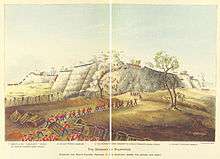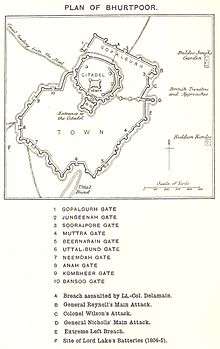Siege of Bharatpur (1805)
| ||||||||||||||||||||||||
The Siege of Bharatpur took place between 2 January and 22 February 1805 in the Indian Princely state of Bharatpur (now part of Rajasthan), during the Second Anglo-Maratha War. Forces of the British East India Company, led by General Gerard Lake, were four times repulsed in attempts to storm the fortress. The victory by Bharatpur backed by the Maratha Empire was an embarrassing defeat for the British.
Background
The raja of Bharatpur, Ranjit Singh had promised to join the British but instead formed an alliance with the Indore Maharaja Holkar, who was allied to the Maratha Empire.[1] Holkar suffered setbacks with the British at the Battle of Deeg and the Siege of Deeg Fort. However, Ranjit Singh "came out openly on Holkar's side after the defeat of Monson." Lake arrived at the Bharatpur fort on 2 January 1805.[2]
Siege


The British bombardment started on 7 January 1805, and a breach was effected on 9 January. The first British assault took place that night, led by Col. Ryan, Maj. Hawkes, and Lt. Col. Maitland. The assault failed with 400 British casualties, including Maitland being mortally wounded. A second attack on 16 Jan was also thrown back, after the Marathas added water to their moat. British casualties were 500, including the assault leader, Lt. Col. MacRoy. However, Lake continued to receive supplies and reinforcements, including Maj. Gen. Jones' force of 1600. This helped Lake deal with Amir Khan, Holkar's general, who was raiding Bundelkhand. A third assault on 20 February also failed, as did a fourth assault the next day. British casualties for all four assaults were 3292. "The worst part of it was that many of the wounded were left behind where they had fallen. The defenders sallied out from the fort and killed them."[2]
Aftermath
"Ranjit Singh "decided to accept the British offer", and paid the British an indemnity, which "allowed him to retain all his possessions", including Deeg. Caught between three British armies, led by Lake, Gen. Jones and Col. Ball, Holkar sent emissaries to Lake. A treaty was signed on 24 December 1805, in which he gave up any claim to Tonk, Rampura, and Bundi.[2]
References
- ↑ Grant 1885, p. 576.
- 1 2 3 Naravane 2014, p. 9396.
- Bibliography
- Grant, James (1885). British battles on land and sea.
- Naravane, M.S. (2014). Battles of the Honorourable East India Company. A.P.H. Publishing Corporation. ISBN 9788131300343.
Coordinates: 27°13′12″N 77°29′43″E / 27.2199°N 77.4954°E